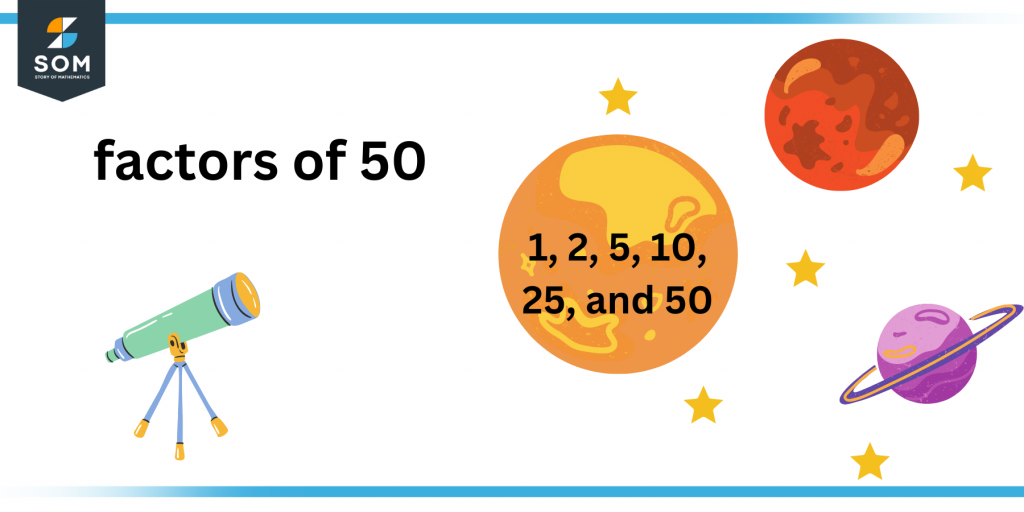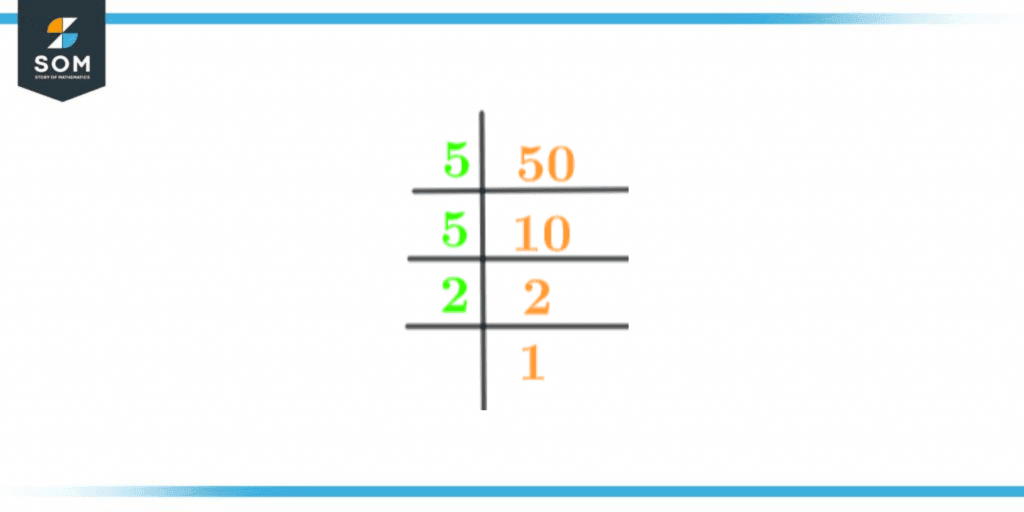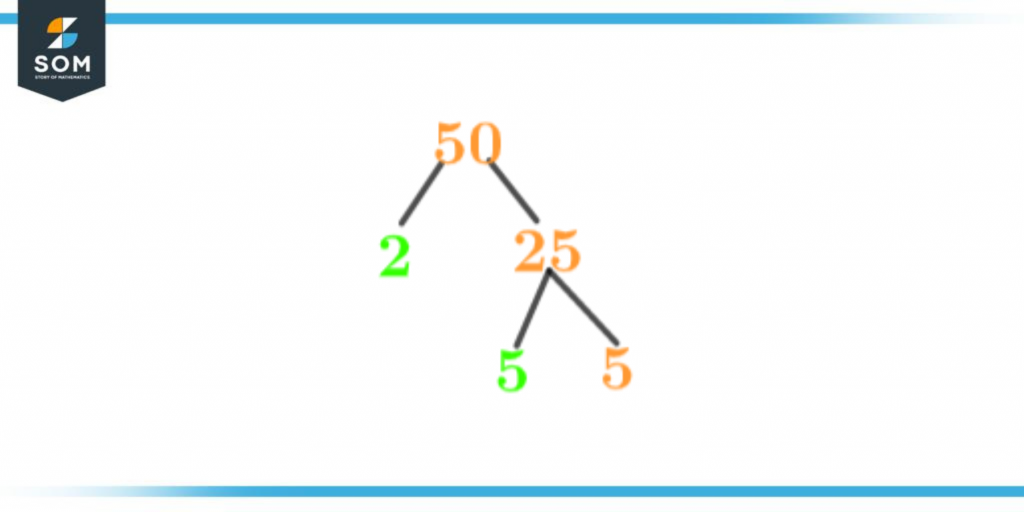JUMP TO TOPIC
Factors of 50: Prime Factorization, Methods, Tree, and Examples
The numbers that, when multiplied together, equal 50 or by which 50 can be completely divided are referred to as factors of 50. As a result, a number is said to be a factor if it divides 50 with a remainder of 0. Make a list of all the integers that are smaller than or equal to the number you are seeking for factors to examine factors.
Figure 1 – All possible Factors of 50
What Are the Factors of 50?
The factors of 50 are 1, 2, 5, 10, 25, and 50. Thus, 6 numbers give off no remainder when divided by 50. As it is a composite number, 50 has more than two factors.The number multiplied in pairs to form the number 50 are known as pair factors of 50, and they include (1, 50), (2, 25), and (5, 10).How To Calculate the Factors of 50?
You can calculate the factors of 50 using the division method and prime factorization technique. Let’s look at how the methods given at the beginning of this article can be used to determine the factors of 50.Write down half of the number you were given first – for example, half of 50 is 25. As a result, you must determine if any number from 1 to 25 can be divided by 50. Remember that for a number to be a factor of 50, it must be divisible by a number that leaves a zero-valued remainder, and the divisors should only result in whole number quotients. It won’t be counted as a factor either if the number gives a result in decimal. The primary division procedure to calculate a factor of 50 is very simple. As every number is divisible by 1, so, 50 is divided by both 50 and 1 without any remainder. Determining whether 50 is divisible by 2 is the next step in determining the divisibility between 1 and 50. \[ \frac{50}{2} = 25 \]This shows that 2 and 25 are factors. Next, we move on to 3 and find out that it’s not a factor because the answer is a decimal number. \[ \frac{50}{3} = 16.66 \]Then we keep on checking other numbers until we find all the factors of 50. Below is a list of all the factors of 50: \[ \frac{50}{1} = 50 \]\[ \frac{50}{2} = 25 \]\[ \frac{50}{5} = 16 \]\[ \frac{50}{25} = 2 \]\[ \frac{50}{50} = 1 \]Therefore, all the factors are 1, 2, 5, 10, 25, and 50. Now let’s take a look at the multiplication method to find the factors of 50. Consider the number 50 to be the outcome of two whole numbers in all feasible ways. Every single integer that appears in each of these products is a factor of 50.1 x 50 = 50
2 x 25 = 50
5 x 10 = 50
Thus, the factors are 1, 2, 5, 10, 25, and 50.Factors of 50 by Prime Factorization
The method of prime factorization, which entails figuring out which prime factors can multiply with one another to get the number as a product, is one way to express a specific number as the product of its prime factors. To put it another way, it is a technique for determining or representing a given integer as the sum of prime numbers. 1 and the number itself are the only two factors that make up a prime number. Given that 50 is a composite number, it should have prime components. Let’s look at how to recognize the main variables. Divide 50 by the smallest prime factor-take let’s 2 as an example in the first method. Since 50/2 divides into a whole number. As a result, it is a factor. \[ \frac{50}{2} = 25 \] 3 is not a factor as the outcome of dividing 50 by it does not produce a complete number. \[ \frac{50}{3} = 16.66 \]We now go on to the following prime numbers, which are \[ \frac{50}{5} = 10 \]\[ \frac{50}{50} = 1 \]After the division procedure, we were given the number 1. We ultimately can’t go on because of it. To denote the prime factors of 50, the notations 2 x 5 x 5 are used. Prime numbers 2 and 5 are those in this example. The prime factorization of 50 can be seen below:
Figure 2 – Prime Factorization of 50
Factor Tree of 50
Even the factors of a number can be stated in various ways. The prime factors of a number can be graphically represented in a variety of ways, one of which is by expressing factors as a Factor tree. The real number serves as the root of the factor tree, and the branches that sprout from it represent factors until you reach the prime number.As a result, according to prime factorization, 2 and 5 are 50’s prime factors. Therefore, the factor tree’s last representation of an integer should be 5. The diagram of the factor tree of 50 can be seen below:
Figure 3 – Factor Tree of 50
- 50 is the 25th even number. Also, the least number that can be obtained by adding two non-zero square numbers in two different ways is fifty: 12 + 72 = 52 + 52
- 50 is a Harshad number, a Stirling number of the first kind, and a Narayana number. 3. It is the sum of three squares that is 32 + 42 + 52 = 9 + 16 + 25 = 50. Furthermore, 50 is a caliber of ammunition.
- 50 can be represented as 110010 in the binary number system and nuclear physics is the fifth magic number.
- 50 is the atomic number of tin. Moreover, fifty is the standard lens’s focal length for 35 mm photography, measured in millimeters.
- The United States of America is made up of 50 states. Also, each team has 50 overs to bat during one-day cricket matches.
- 50 in terms of years of marriage is regarded as the gold wedding anniversary, and it is the undefined speed limit on Australian and Canadian roads in kilometers per hour. 8. 50 is the proportion corresponding to one-half. (50%) The term “fifty-fifty” often refers to something that has been divided in half, and is used to communicate this; in business, this is frequently used to refer to the highest level of equal partnership.
Factors of 50 in Pairs
A pair of numbers that, when multiplied together, equal 50 are called factors of 50. Here are the factor pairs: If 1 x 50 = 50, then the pair factor of 50 is (1, 50). Likewise, let’s examine further pairs:2 x 25 = 50, (2, 25) is a pair factor of 50.
5 x 10 = 50, (5, 10) is a pair factor of 50.
These are the positive factor pairs of 50. To find out the negative factor pair, all you have to do is to reverse the signs. The negative factor pairs are as follows: If -1 × -50= 50, then (-1, – 50) is a pair factor of 50. -2x-25 = 50, (-2, -25) is a pair factor of 50. -5x-10 = 50, (-5, -10) is a pair factor of 50. Thus, these are the negative factor pairs of the integer 50.Factors of 50 Solved Examples
To help you learn more about the factors of 50, take a look at the examples given below.Example 1
What are the common factors of 50, 70, and 125?Solution
Factors of 50: 1, 2, 5, 10, 25, and 50.
Factors of 70: 1, 2, 5, 7, 10, 14, 35 and 70.
Factors of 125: 1, 5, 25, and 125.
Hence the common factors of 50, 70, and 125 are 1 and 5.Example 2
What is the addition of all the factors of 50, including 50?Solution
The factors are 50 are 1, 2, 5, 10, 25, and 50. So, the sum is 93.1 + 2 + 5 + 10 + 25 + 50 = 93
Example 3
What is the subtraction and addition of the prime factors of 50?Solution
The prime factors of 50 are 2 and 5.Addition: 5 + 2 = 7
Subtraction: 5 – 2 = 3
All images/mathematical drawings are made by using GeoGebra.